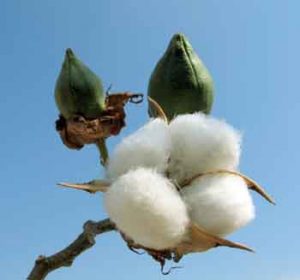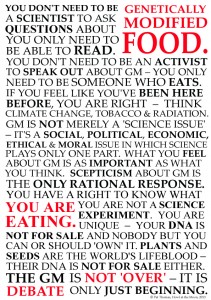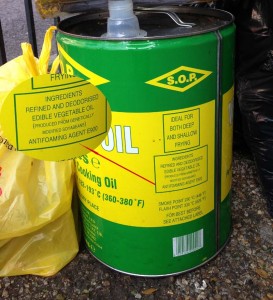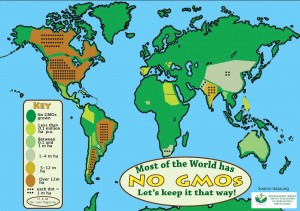
More evidence that low-calorie sweeteners are bad for your health
Studies show that artificial sweeteners can raise the risk of hypertension, metabolic syndrome, type 2 diabetes and heart disease, including stroke.

Q — I understand why I should be concerned about GMOs in food, but surely other types of GMOs that we don’t eat, like cotton, are less of a threat. Can you explain?
A — The vast majority of GMOs that we come into contact with are agricultural products (a few are whipped up in the lab). Their use in agriculture causes problems for farmers, for the environment and for us.
These crops are, for example, grown, out in the open, where they can cross pollinate with other plants, and where they are sprayed with large amounts of toxic pesticides, which drift on the air into other fields and into our homes, our playgrounds and our lungs.
Here are some issues to consider:
Compassionate shopping

There are lots of valid reasons to oppose GMOs, and lots of valid ways to express that opposition (Image: Pat Thomas, Howl at the Moon). Click to enlarge.
In countries like India, farmers have been pushed into abandoning food crops for large tracts of GM cotton. These large monocultures are not only bad from an environmental point of view; they mean that the farmers are caught on a treadmill of debt that they cannot get off (for more check out the UK Soil Association’s organic cotton initiative).
GM seeds cost more than conventional seeds, the plants they produce have not proven to be pest-resistant as advertised, and farmers end up spending more on pesticides and producing smaller yields. Far from improving the lives and livelihoods of these farmers, GM cotton has destroyed many lives and left many more farmers in poverty.
If you believe in compassionate shopping, for instance if you buy Fairtrade goods or look for cruelty-free labels, then you should also avoid any cotton products which do not state that they are explicitly GM-free – as these are likely implicated in gross cruelty to farmers in the developing world.
Remember also that cotton doesn’t just produce cloth; it also produces a valuable oil which is widely used in food manufacture. So somewhere along the line you will be eating the products of this ‘non-food’ GMO.
GMOs put the ‘junk’ in junk foods
Something to remember in the bigger picture of the food/non-food debate is that for the most part we don’t eat GMO ‘foods’ directly – we eat junk foods which have been made with GMO ingredients. These ingredients, which sneak into our diets largely unnoticed, are made from GM crops and from GM additives that are made in laboratories.
We also eat animals that are fed on GMOs and traces of these organisms can be found in their meat and milk.
As the illustration to the right shows, as long as you only eat fresh produce and pasta, rise and pulses you are (mostly) OK.
But once you stray into the territory of eating meat and pre-prepared foods and snacks, industrial bread products you will be eating a GMO diet.
But GM also goes into non-food items
As you rightly say there are non-food GM products as well, for example:
Why should this matter to you
It’s easy only to look at the debate from a food/non-food perspective but the truth is we cannot uncouple the effect of agricultural GMOs from our health – even if we don’t eat the final product.
When you buy GMO products whether they are food items or non-food items you are supporting a system that absolutely works against your health and well being and that of the entire planet.
You are putting money into the hands of large corporations whose goals are:
That money is used against you. It is used to pay for campaigns to stop labelling initiatives in the US. It is used to pay scientists-for-hire to say that GMOs are unequivocally safe – when there is no science to justify this statement. It is used to grease the political and regulatory machinery (bribery and corruption it used to be called) to ensure that more GMOs, and more of the toxic pesticides that are used on them, continue to be licensed and sold.

Think your neighbourhood is free from GMOs? Our editor snapped this picture outside a take-away restaurant half a block from her home. Click to enlarge
So why aren’t scientists speaking out?
Some people feel the GM issue is too complex for them to comment on. But remember it is in the interests of GM corporations to make people feel both helpless and stupid when it comes to GMOs. That way not one will feel confident to question their continued development and uncontrolled planting and dissemination into the human food chain.
Much the same thing has happened with climate change which is a similarly complex and nuanced issue. Scientists have been saying for years that man-made climate change is a problem, that it threatens our health, wealth and security.
The evidence is undeniable. And yet corporations have spent billions on misinformation campaigns – which include employing rent-a-quote scientists to spread confusion and dissent. The same is true for GMOs.
People’s awareness of the complexity of the GMO issue has been exploited in the media by pro-GM groups who try to suggest that opposition to GMOs is being led by frightened and largely ignorant consumers. It is not, and the now bi-annual, global Marches Against Monsanto – the next one is May 24th – have provided a useful outlet for concerned citizens to band together with greater confidence and a louder voice.
Scientists have also been vocal, and continue to speak out, on GMO issues.
In 1999, shortly after widespread planting began, a World Scientists Statement signed by 828 scientists from 84 different countries expressed deep opposition to GMOs.
Recently the European Network of Scientists for Social and Environmental Responsibility wrote an open letter to say there was no scientific consensus on the safety of GMOs, and that the animal and laboratory evidence is such that GMOs should be withdrawn until such time as they can be proven safe. This letter was signed by 300 scientists from around the world and the number of signatories continues to grow.
A threat to independent science
Many scientists would like to study GMOs and their effects. But because companies like Monsanto and Syngenta own the patents on GMO products and procedures, they have total control over who gets to study them. An independent scientist who asks for samples of GMO maize or soya to grow or study will likely be told ‘no’.
An independent scientist who asks to review the corporate scientific data on the safety of GMOs will be told that such data is private and will be denied access to it.
When the famous Séralini paper showing a high degree of toxicity and unexpected tumours in rats fed a lifetime diet of GMOs was withdrawn, it shone the harsh light of reality on the extent to which corporate interests influence scientific studies and scientific discourse and there was uproar in the scientific community.
On its withdrawal 150 scientists gathered together under the banner of End Science Censorship to sign an open letter demanding its reinstatement.
So if it’s everywhere, is it hopeless?
It’s not everywhere and it’s not hopeless, but that doesn’t mean we can sit back and relax.
How you view the particular threats of GMOs to your health, your community and the wider environment depends largely on you live and what newspapers you read. Stories about…
…can make us believe that GM is more successful and innovative than it actually is. They are the shiny toys waved in front of the public’s face to distract it from the steady and risky creep of GMOs onto agricultural land and into the food supply.
Likewise some countries have embraced GMOs more than others. For example, the vast majority of GM crops (90%), and almost all (99%) GM food crops, are grown in the US, Argentina, Brazil, and Canada.

The Americas grow by far the most GM crops in the world (Image: Fairlie & Barron, The Land Magazine). Click to enlarge
The US produces almost half of the world’s GM crops; in total 94% cotton, 93% soybeans, 88% corn planted in the US are GMOs.
In the US, for example GMOs are ubiquitous and eating a non-GMO diet requires a continual, conscious and conscientious effort. Vocal protests about GMO labelling are a direct result of people wanting to know more and eat more consciously.
In the Europe things are different. Only two commercial GM crops have been approved in the EU.
One is a pest-resistant Bt maize (known as MON810) grown mainly for use in animal feed; the other is the Amflora potato, genetically modified to produce starch for use in paper-making, grown in small quantities in Sweden and Germany between 2010-12 before being withdrawn.
In the EU there is more organic land than GM land under cultivation. In 2011, GM crops were grown on 0.1% of arable land in Europe, compared with nearly 4% for organic. Nevertheless, Europeans are still eating animal products from animals fed on GMO feed, much of which is imported from the Americas.
Globally the picture is different still: 37 million ha (2% of agricultural land) under organic cultivation compared to 170 million (12%) under GM cultivation.
That means that majority of global land is still GM free – and we as consumers, and voters, have an opportunity to keep it that way, and even reverse the trend if we keep the pressure up.

Please subscribe me to your newsletter mailing list. I have read the
privacy statement